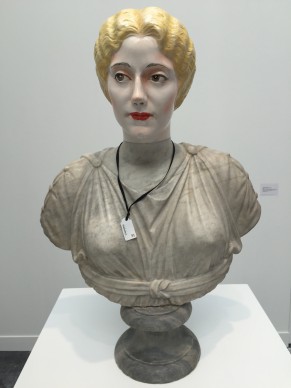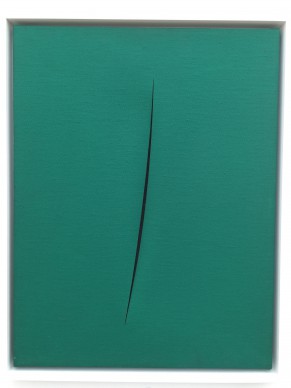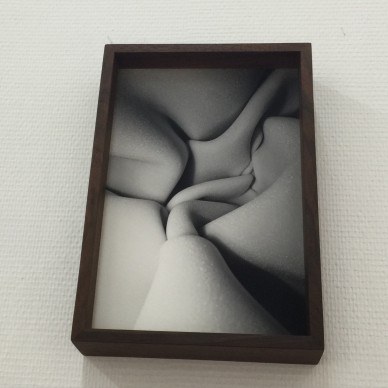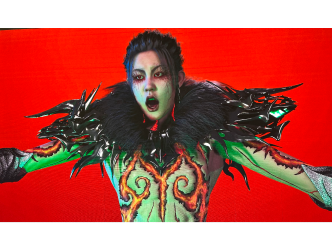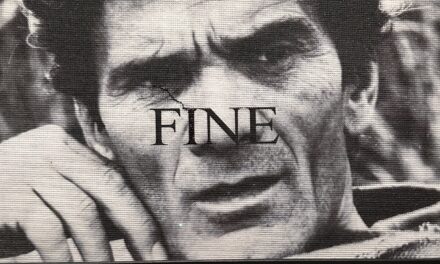How many images is a 21st-century human being capable of absorbing in a few hours? In October, contemporary art aficionados can suffer a severe overdose in this field. If they’ve stopped by Frieze and Frieze Masters, plus added a few galleries and museums in London last week, this week they find themselves in Paris at a high risk of overdosing indeed. The French capital has never reached this level of offerings in terms of current art production before: Art from the 20th and 21st centuries is everywhere in Paris—in fairs, exhibitions, events… even outside Paris proper.
But let’s not complain, and let’s say this right away: At the Grand Palais, FIAC has reached a level of excellence. Not so much its “Officielle” annex, located in a highly unattractive building in the 13 rd arrondissement. What’s Officielle anyway? A concept for a fair without its own identity in a difficult neighborhood.
Like all pertinent and economically viable fairs, the leading French fair has become a contemporary art hub primarily composed of foreign galleries that sell primarily to foreign clients.
Out of 242 galleries at the FIAC Grand Palais and FIAC Officielle at the Cité de la Mode et du Design, 59 are French. The event is opening in a tumultuous context this year, with economic turmoil from Latin America to China, which are the new big art buyers. Frenchman Matthieu Paris, who heads up private sales at London’s White Cube gallery, notes: “There’s no slowing down of activity on the international level. It’s just that demand tends to go toward safe values in contemporary art, emblematic works by known artists. In contrast, for very young artists, except three or four of them, any activity and, by extension, any speculation, has disappeared.”
Why are fair constantly attempting to get bigger? To make more money. But as we saw last week in London, thanks to its quality (it showcases contemporary art classics) Frieze Masters is killing off Frieze London, which has become a much too noisy bazaar (it showcases contemporary artists, who by definition are uneven). In Paris, the Grand Palais’ restrained space is sufficient for visitors who aren’t in search of gargantuan visual nourishment. By contrast, these visitors will quickly become sated visually in the context of noisy throngs.
A great many good things, surprises and amusing stories can be found at the Grand Palais. As any piece of theater, the fair can begin with red curtains in motion: in this case, those created by Martin Creed at the Gavin Brown booth. Creed won the 2001 Turner Prize with a piece that consisted of lights being constantly turned on and off. He’s continuing his own “Masterpiece Theater” with immense red curtains that constantly open and close access to the New York gallery space. These curtains are being sold for $150,000.
One of the fields that have shown the most increase in recent years is Italian art. Several galleries from the Peninsula have settled in London. Such is the case for Tornabuoni, which has also elected residence in Paris, has a booth at FIAC and has become a major specialist in the field. There is an international demand for contemporary Italian art these days, and billionaires such as Canadian Lawrence Stroll (who’s worth $2.4 billion, according to Forbes magazine) have obviously decided they would build a collection in this field. Indeed last year, Stroll acquired a white monochrome canvas by Piero Manzoni (1993–63) for 15.7 million euros, a record for the artist. But the star of this classic Italian contemporary art movement is clearly Lucio Fontana (1899–1968). His works offer several advantages for the market: they are decorative, plentiful and easily identifiable. The record for Fontana was reached on October 15 in London for a monochrome oval canvas cribbed with crater-like holes and titled The End of God. Apparently, some time ago, the Nahmad family of British-American dealers had sold the canvas for $35 million to a Malaysian collector, who reportedly faced cash-flow difficulties shortly thereafter. In October, this collector let Sotheby’s London auction it off for 26.8 million euros, some $5million less than what he’d spent earlier.
At Belgian gallery Vedovi’s booth, a Fontana Concetto Spaziale, a green monochrome slashed canvas, is for sale for about 1 million euros. In Mimo Vedovi’s opinion, five years ago that canvas would have changed hands for half that price.
On the second floor, Plan B, the excellent Romanian gallery, is showing recent works by the talented, and also Romanian, painter Victor Man, who lives in Berlin. A not-quite-graceful young woman is bathed in green light; the artist seems to have painted the plants around her for his own pleasure. Its title, in French, is, “Qui es-tu des Esseintes,” which doesn’t belie the artist’s melancholy spirit: It refers to the solitary hero that 19th-century French novelist Huysmans created in his À Rebours (Against Nature). The painting is on offer at the same price as the self-activated red curtains.
Italian artist Francesco Vezzoli also celebrates past heroes. He’s applied gaudy paint to a marble sculpture he christened with the name of actress Jane Mansfield. In fact, and this is not commonly known, sculptures in antiquity were similarly painted in polychromatic fashion, as was recently shown at Milan’s new Prada Foundation. Turin’s Franco Nuero gallery is asking $200,000 for this sculpture. We’re still in the same price range. Until we reach Thaddaeus Ropac’s booth and see a huge 1979 collage-canvas by mega artist Robert Rauschenberg, which is for sale for $1.5 million.
It’s time to rediscover old, forgotten or underestimated contemporary talents. They make you feel safe. Brussels- and Brooklyn-based gallery Clearing is bringing an interesting British artist with an Italian name, Eduardo Paolozzi (1924–2005). out from oblivion. The gallery is presenting one of his reliefs from 1973, made from an accumulation of wooden forms, like a utopian architecture model, for sale for $165,000.
But in order to see what’s brand-new, light, joyful, cheap-and-cheery trashy, you have to make your way to the latest fair, created just this year at the initiative of a handful of likeable young French galleries, Paris Internationale. Make note of its address: 45 avenue d’Iéna. There, in a vacant town house, 40 galleries hailing from Los Angeles to Berlin are exhibiting their artists. What’s interesting? Mexican artist Martin Soto-Clemente, playing with folds of leather stretched on canvas to evoke the body’s intimate folds ($7,000 at Clifton Benvenuto); at Sultana, British artist Clelia Hampton, painting the bodies of immodest men (starting at 7,000 euros); and Renaud Jerez, inventing the robots of a DYI future (9,000 euros at Crevecoeur). And, and… How many images can a 21st-century human being really absorb in a few hours?
Support independent news on art.
Your contribution : Make a monthly commitment to support JB Reports or a one off contribution as and when you feel like it. Choose the option that suits you best.
Need to cancel a recurring donation? Please go here.
The donation is considered to be a subscription for a fee set by the donor and for a duration also set by the donor.

